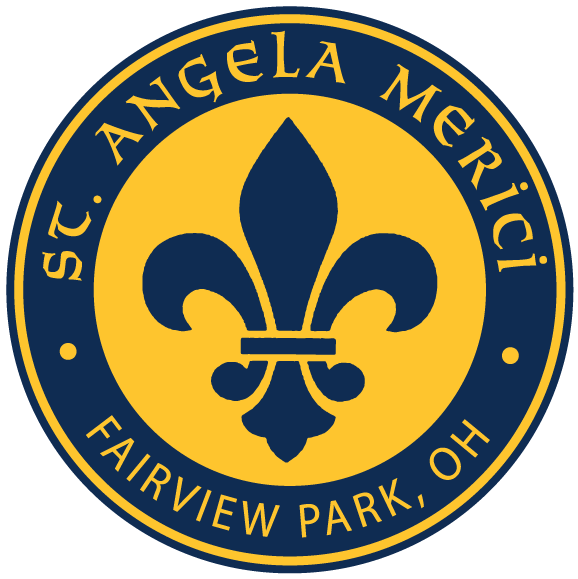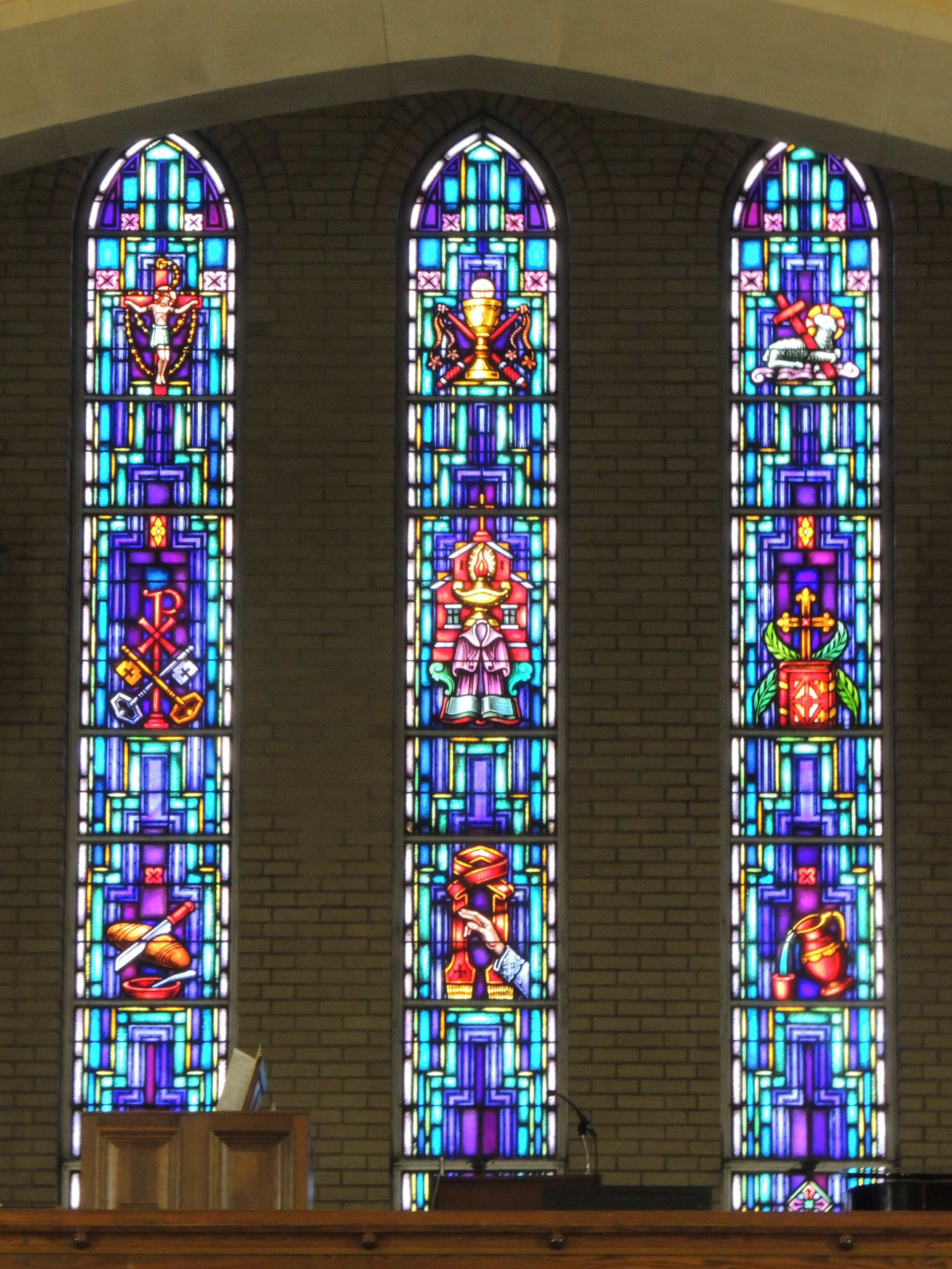TRINITY WINDOWS
Among the treasures of the Saint Angela Merici Parish Church, are the Trinity Windows in the south façade of the choir loft. These windows were likely designed to complement a similar pattern in the original 1924 Frame Church and School.
There are a total of nine images, three set forth in each of the three vertical windows. As with all stained glass windows, they are designed to be viewed from the inside of the building, looking out towards the sun, with the light providing illumination. This becomes a metaphor for the human soul and the human person, where the beauty lies within, from the inside toward what is exterior.
Left Window, Top
Jesus Christ on the cross surrounded by a rosary. This depicts the crucifixion and the reminder that the cross is our salvation. What was meant as a means of torture and humiliation has become for us the symbol of our triumph. This style of presetning the body of Christ on the Cross developed during the medieval period when the theology began to focus on the passion of Christ.
The rosary tells the story of Chirst in the full 150 mysteries of the nativity, the death, and the resurrection of Christ. All of the mysteries are rooted in scripture. The Joyful Mysteries tell of the Incarnation and the birth of Christ. The Sorrowful Mysteries tell of the passion and death, and the Glorious Mysteries tell of the triumphant Resurrection. Through the Cross and with the use of the rosary, the faithful are able to contemplate the deep mysteries of our salvation through the life of Christ.
Left Window, Center
This is the symbol known as the Chi-Rho, the first two letters of the Greek, Christos, meaning Christ, the annointed one. This symbol appears early in Christian art form, mostly on tombs. There are the keys, the way to open our way to heaven, the Keys to the Kingdom. Jesus gave to Peter and his Church this power of the keys, in terms of leadership and in terms of the power to forgive sins. Jesus is sometimes referred to as the Key of David. The Key is the metaphor for finding the treasure of the secret of life. St. Paul tells us about this secret, and Christ is the secret of life.
Left Window, Bottom
s is the loaf of bread, with the knife. This would refer to the Old Testament tradition of bread from Gid, memorializing Gid’s gracious bounty to his people. When the Isreali people were hungry during their Exodus, God provided them with manna from heaven. In the New Testament, following this tradition, bread is the symbol of the Holy Eucharist, Christ, the Bread of Life.
Jesus distributed bread along with the fish to feed the 5,000 came to hear him. The presence of the dish and spoon would also refer to the Eucharist, as in the Eastern Rite, where the host was dipped into the wine and placed on the tongue of the faithful with a spoon. This was sometimes known as “intinction”.
Center Window, Top
The chalice and host. The Chalice can also be used as a symbol of the virtues of Faith, Hope and Charity. The base of the Chalice is meant to be broad and sturdy, similar to our Faith. The stem of the Chalice can be likened to Hope, the virtual by which we are united with God. The cup of the Chalice are symbolic of wings, spread outward and upward like the virtue of Charity, spreading outward to all those who are our neighbors.
The latin works for host is “hostium’, meaning victim. The host received in Holy COmmunion os the Body of Christ, the victim, whose life is given over as victim for our salvation. Together, the Chalice and Host represent Christ in Hid Blood and Body, given over for our salvation.
There are also portrayed swords and whips. symbols of death and destruction, as of the Eucharist, since the bread and wine come forth only when the wheat and the grapes are totally destroyed and transformed.
These symbols and reflections become an invitation for each participant to enter the Church as one person and experience internal change and personal conversion, leaving transformed and renewed.
Center Window, Middle
This is the eternal flame, suggesting the presence of the eternal God, the never-ending divinity who created the world and who will preside beyond time. Fire and flame appear often in the Bible, mostly in reference with the Holy Spirit. It also consumes, purges, cleanses and purifies. It provides light, wisdom, knowledge and understanding.
There is also a robe, which is symbolic of the robe that Christ wore to his death. The seamless robe of Christ symbolizes the unity among all who believe in Christ and is meant to challenge Christians to accept all teaching of Christ in the Gospel.
Center Window, Bottom
This is the stole, the symbol of office. Here, representing the symbol of the office of the ordained priesthood and the priest in his responsibilities when administering the sacraments of the Church.
The hand is that of the priest who bestows upon the faithful the grace of God and the peace of Christ. This hand, blessed at ordination, offers the absolution of the Church in the sacrament of Reconciliation and offers blessings of the anointings in Baptism, Confirmation and the anointing of the sick and dying.
Right Window, Top
This portrays the image of the lamb and the sword, placed on a book. Christ called himself the Lamb of God, offering himself as the victim for mankind. In the older Latin tradition of the Mass, we called this the Agnus Dei. Christ is the innocent lamb offered in sacrifice for our sins. When Jesus was first presented to the Temple, Mary was warned that a sword would pierce her heart. When Jesus was on the Cross, they pierced his heart with a lance. The book is the Bible, the story of God’s love for his people and his constant fidelity in pursuing his people, even when they abandon God.
Right Window, Center
Again we are presented with the cross, this time with the Bible and green vines. The vines could be those of the olive. The Holy Oils used in Baptism, Confirmation, Anointing and Ordination are taken from the olive, long regarded as the source of life, or power, or courage. The vines could represent the palm leaves used to welcome Jesus into Jerusalem, now used to celebrate His death and resurrection during the Easter liturgy.
The palms are also consumed by fire each year to provide us with the ashes for Ash Wednesday. Christ called himself the vine and invited us to be the branches of his living tree. We are to bear the fruit, but we are to get our strength and inspiration from Him. The vines provide grapes which, through their own total death and destruction, give us the wine which becomes the Blood of Christ during the Eucharistic celebration
Right Window, Bottom
This is a pitcher and water, making reference to our Baptism, the gateway to the sacraments. Water is the symbol of cleansing, or purification. Water is the most basic staple of human life on Earth, without which humans would die.
Water reminds us of Christ when he washed the feet of his disciples on Holy Thursday. Water reminds us of the holy water that greets us as we enter the Church to bless ourselves. Water reminds us of the wedding feast at Cana where Jesus took jars of ordinary water and transformed them into wine.
During the Holy Sacrifice at the Mass, water is mixed with the wine. This has many symbolic meanings. One is that our humanity is united with Christ in his sacrifice. Another is the symbolism of the universality of the Church, all joined together in this one sacrifice of the Mass.
The gesture of introducing the water with the wine is an opportunity for each participant to offer a prayer seeking unity with Christ, and to seek unity with all those who are praying the congregation, and all Catholics throughout the world.










